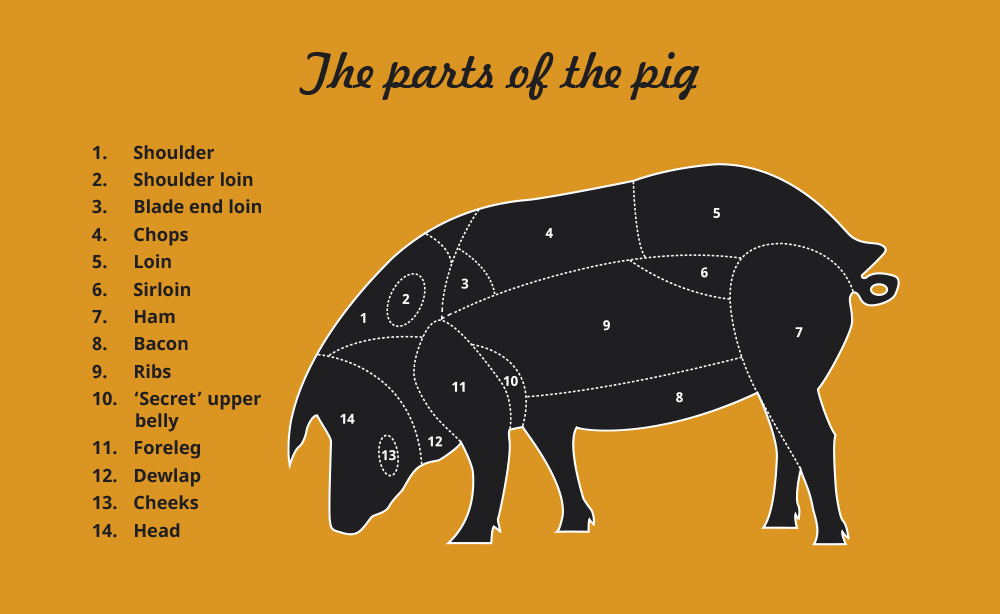Everything you need to know about pigs. Because in Spain we are specialists in using every single part of the pig.
The traditional carving up of a pig has varied a little over the last few years, and you can now find different cuts on the market that haven’t been sold separately before, at least not in general.
Leaving offal to one side, the ‘tocino’ fatty bacon – traditionally used for cooking (although now not so popular because of its high fat content) and for pressed meat – and the use of blood to make black pudding or simply to eat fried, we would like to run through the ‘map’ of the pig so you can find out where each part comes from.
The shoulder is a very meaty part from the front of the pig. Its high collagen content makes it ideal for stewing, but it is also usually eaten breaded or simply on the grill.
The shoulder loin is one of those parts that has been ‘rediscovered’ in the last few years. It is an oval part, located above the leg. It forms part of the head of the loin, and it is perfect for roasts or filleted and char-grilled.
The blade end loin is a relatively small triangular part that is at the front end of the loin. Long and thin, only two are extracted from each pig, each weighing around 100 g. Fine, tender and delicate, the blade end loin is a delicacy to char-grill.
Chops and the loin are two classics in our cuisine. Either on the bone (firm-favourite pork chops) or just the loin (separated from the spine), it is very juicy lean meat that can be used for any type of preparation.
Just as for beef, the sirloin is one of the most highly-appreciated parts of the pig. This is delicate meat, smooth and aromatic, that can be served with almost anything. It is found in the lumbar region, between the ribs and the spinal column, just in front of the ham.
What can we say about ham? For us, there’s no doubt that this is the best part of the pig. Although it is eaten all over the world, only Italy and France make a similar product (with some differences). This rear leg, produced traditionally, is one of the quintessential delicacies of the highly-appreciated Spanish cuisine.
The streaky bacon, as its name suggests, is a fatty part of the pig meaning the lean and fatty combination that is in the belly and runs along the ribs. Although it has become more popular to eat bacon in Spain (the word has Chinese origins), it can be consumed in different ways. Not only char-grilled or grilled, it has been traditionally eaten salted and cured like ham.
We don’t need to explain where the ribs come from, but they still deserve a mention. Like any meat on the bone, it’s a real delicacy.
Another cut that has become more fashionable recently is the ‘secret’ upper belly. It is found between the shoulder blade and the streaky bacon, deep inside and it is a fan shaped muscle. It is known as ‘secret’ in Spanish because it remains hidden if the muscle is not cut horizontally, although people also say that butchers used to keep it for themselves as it was a very tasty part. The best way of eating it is on a hot grill to toast the fat.
The front leg is just that. It is produced in a similar way to ham, but because it weighs less and has a greater proportion of bone, it takes considerably less time to cure. With an intense and very pleasant flavour, this piece is worth less on the market because it gives little meat and is more difficult to cut.
The dewlap is the “fatty sister” of bacon (if that’s possible). It can be eaten fresh, char-grilled for example, but just like bacon, it can be salted or marinated. It is usually eaten with a broth. A real delicacy.
The cheeks are also back in fashion. These are the muscles located either side of the jaw. It is a lean piece of meat, noticeably marbled with fat. As this is a well-worked muscle, it is a very tasty piece that is at its best when stewed.
In the head, we find gelatinous parts that are used to make processed meat (such as tongue) but also ears or lips, other classic Spanish dishes.
And that’s just a general outline. In different areas of Spain, they are bound to use parts of the pig in other ways, but we hope to have been able to shed some light on where some of the most popular cuts come from.


